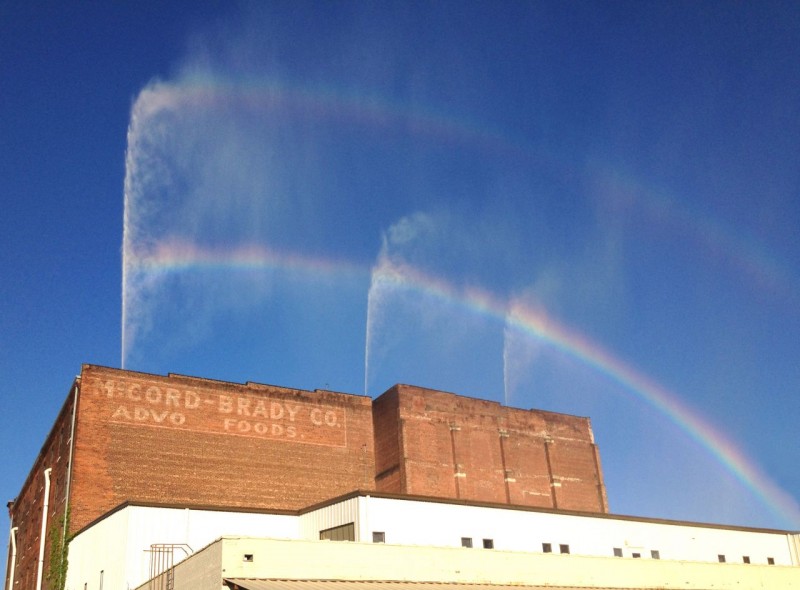
Downtown Omaha, Nebraska, may not be a place you’d expect to see many rainbows, since the state is under an official drought emergency this summer. But art has a way of trumping nature at the Bemis Center for Contemporary Arts. The Rainbow: Certain Principles of Light and Shapes between Forms, an exhibit created by artist Michael Jones McKean, gives residents a glimpse of welcome sights from wetter times. McKean worked with irrigation and rainwater harvesting experts and atmospheric scientists to create the display, in which a dense wall of water shoots up to 100 feet into the air to create a rainbow above the building.
“There are a number of novel aspects of this project,” explains Joseph A. Zehnder, professor and chair of the Department of Atmospheric Sciences at Creighton University, who also served as a technical advisor on rain and wind climatology and on atmospherics optics for the project. “One is that the display is created using harvested rainwater. Local agricultural irrigation and rainwater harvesting companies contributed time and expertise to the project, with the hope of providing a public demonstration of currently available technologies.”
Prior to the opening, a self-contained water harvesting and storage system was built in the Bemis Center. The collected and recaptured storm water is filtered and stored in six above-ground 10,500-gallon water tanks while within the gallery a 60-horsepower pump supplies pressurized water to nine nozzles mounted to the roof. Based on atmospheric conditions, vantage point, available sunlight and the changing angle of the sun in the sky, each rainbow has a singular character and quality.
Zehnder notes that although the basics of rainbows are well understood, there are some complications that arise with providing them on demand. “There are variations in the hue and intensity of the rainbow that are related to the water drop size and density,” he explains. “The drop sizes need to be sufficiently large in order for the internal reflection and refraction of sunlight to occur. Scattering from smaller drops is the wavelength independent Mie scattering so the color separation doesn’t occur.”
McKean began experimenting with manmade rainbows in 2002 and in 2008 started researching the logistics of creating a rainbow over the Bemis Center. In 2010 he started a partial test of the rainbow in Omaha, with the full test last October. “The rainbow is a reminder of a constant universal—something forever, simultaneously contemporary and ancient,” comments McKean. “In the face of our earthbound landscape of shapes and forms, of geologic, evolutionary, archeological timescales, the rainbow is a kind of perfection, our oldest image.”
Even if artists can make their own rainbows, weather still has its say. Because of the dry summer, the Bemis Center is only showing the exhibit on select occasions, with scheduling twenty-four hours in advance. To find out when the rainbow will be on, check here or the Bemis Facebook page. There is also a free mobile app that can be downloaded to Apple and Android phones, which will notify users when the next rainbow will take place and also includes information about the artist and the project.